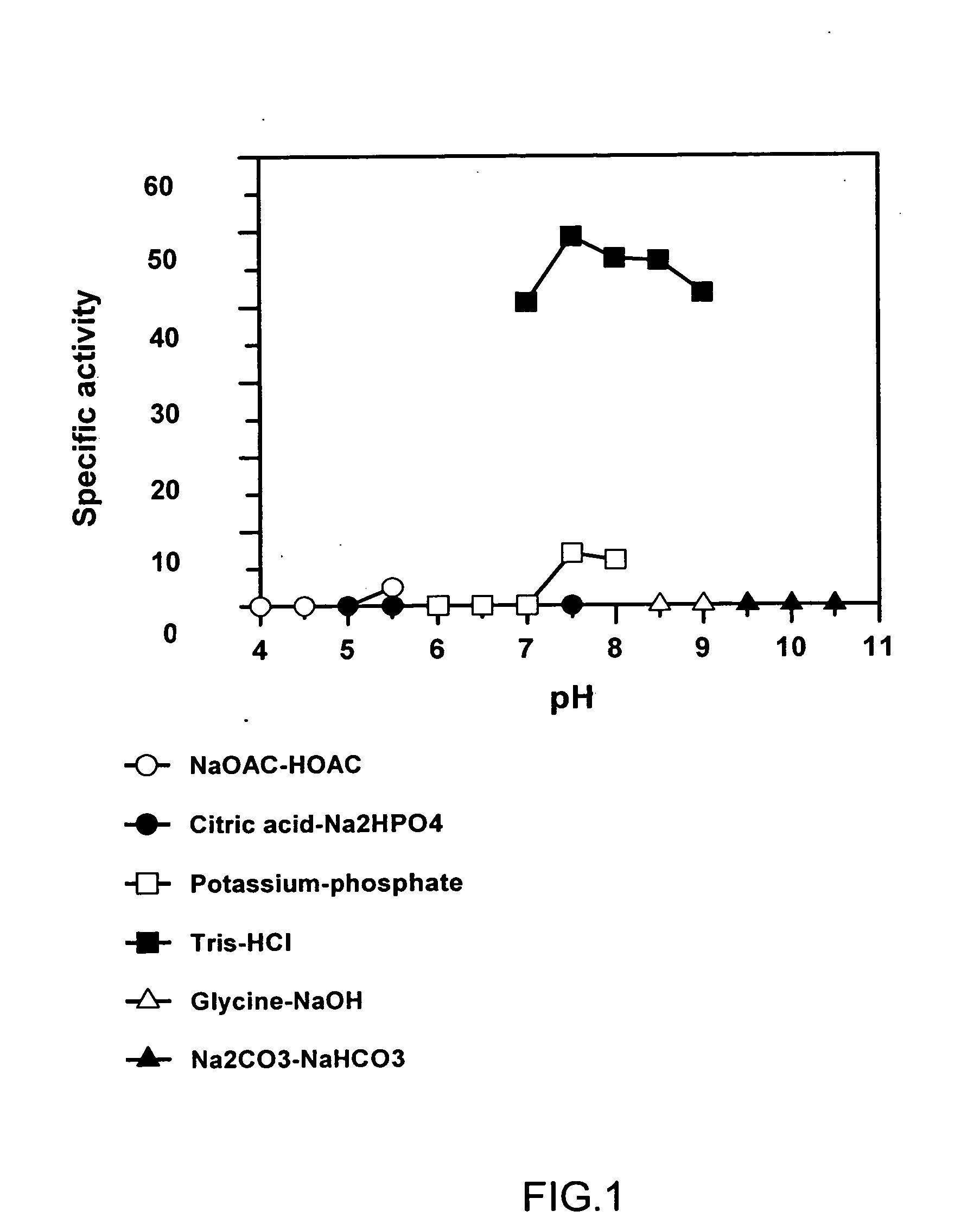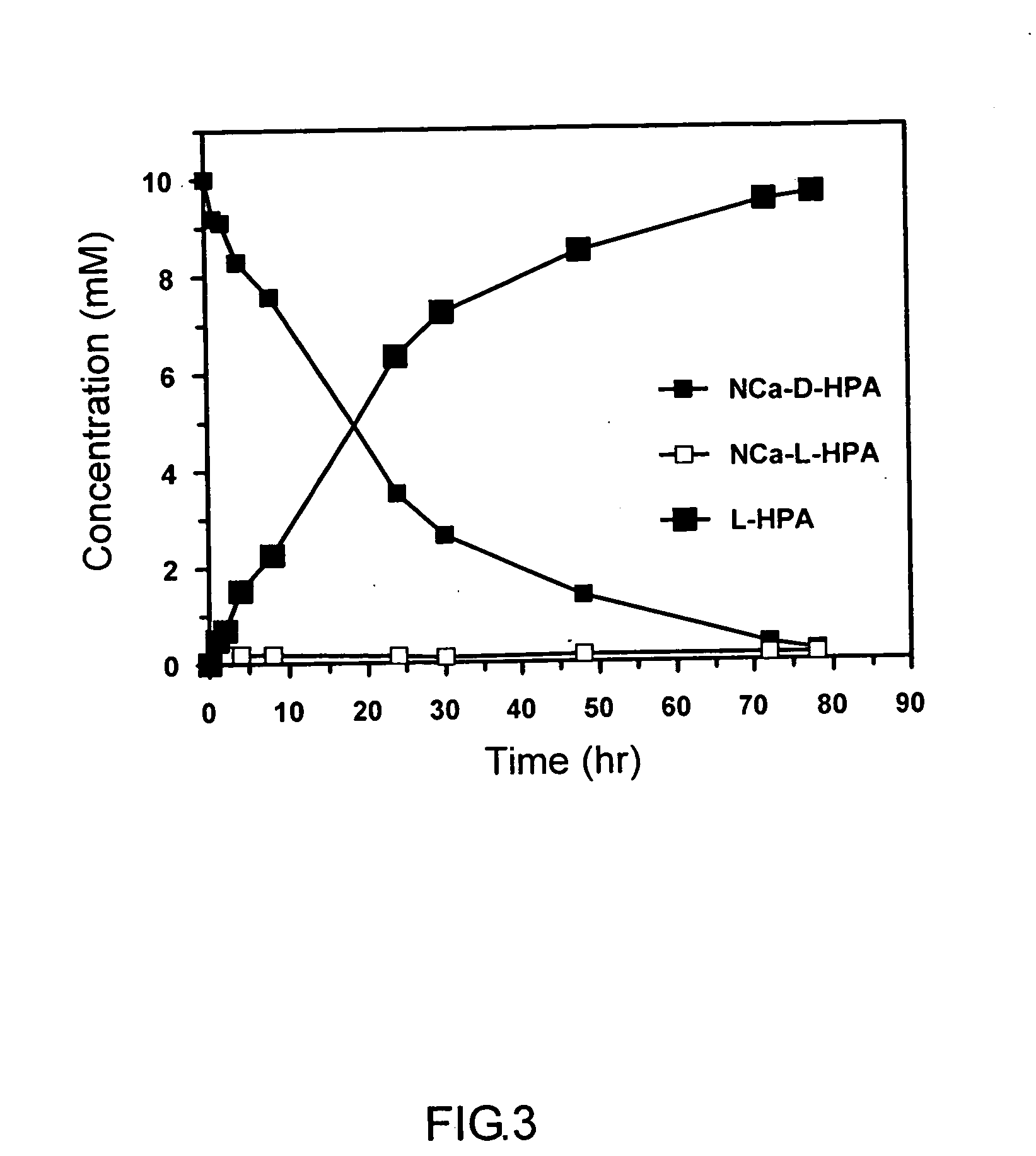Deinococcus N-acylamino acid racemase and use of preparing L-amino acid
a technology of acylamino acid and deinococcus nacylamino acid, which is applied in the field of deinococcus nacylamino acid racemase and the use of preparing lamino acid, can solve the problems of high cost of isolation and purification, environmental pollution, and limited large-scale production, and achieve excellent thermostability
- Summary
- Abstract
- Description
- Claims
- Application Information
AI Technical Summary
Benefits of technology
Problems solved by technology
Method used
Image
Examples
example 1
Cloning and Expression of NAAAR Gene
[0027] The NAAAR gene was amplified by the polymerase chain reaction using primers DRI-01 (5′-CGCGGATCCATGGCGCATACTGGCCGTATGT-3′), containing BamHI restriction site, and DRI-02 (5′-CCCAAGCTTTCACGCCCGGTGTTCCTCCT-3′), containing HindIII restriction site, and Deinococcus radiodurans NCHU1003 chromosomal DNA as template and cloned into a expression vector pQE30 resultant plasmid, pQE-naaar, was then transformed into host cell E. coli JM109 by CaCl2 method. From the sequencing data of isolated NAAAR gene, Table, the idenlity of the present NAAAR with known Deinococcus radiodurans strain is 96%.
[0028] The E. coli host cells harboring pQE-naaar were cultured with shaking at 37° C. overnight in a 500-mL flask containing 100 ml of LB medium with appropriate concentration of ampicillin. After 4 h incubation at 37° C. (OD600 about 6 to 8), isopropyl-β-D-thiogalactoside was added to a final concentration of 0.1 to 1 mM, and further cultured at 30° C. for 6 ...
example 2
Conversion of N-Protected HPA to L-HPA by the NAAAR and L-N-Carbamoylase from Transformed E. coli
[0035] For the co-expression of the NAAAR and L-N-carbamoylase genes in a host cell, we designed two primers at the upstream of T5 promoter and the downstream of λ transcriptional terminator sequence in vector pQE30:
[0036] NCAU (5′-ggcgaggatccatgattcaaggggaacgtc-3′), containing BamHI restriction site; and NCAD (5′-aatttaagcttattccccttgggccagttg-3′), containing HindIII restriction site. The nucleotide sequences encoding the NAAAR and L-N-carbamoylase were amplified from Deinococcus radiodurans NCHU1003 and Bacillus kaustophilus CCRC11223 chromosome, respectively, by PCR technology. The PCR products contained T5 promoter, lac operator and 6×his-tag sequence at the 5′-end and λ transcriptional terminator at the 3′-end. The PCR products were cloned in the pQE30 expression vector. The resultant plasmid, pQEarlnca, was transformed into E. coli JM109 for inductive expression.
[0037] The react...
example 3
Conversion of N-Protected HPA to L-HPA by Whole Cell Preparation
[0038] The E. coli JM109 transfomants harboring co-expression vector, pQEarlnca, were inoculated into 500-mL LB containing 100 ug / ml of ampicillin. The bacteria were cultured at 37° C. until the OD600 reach 1. IPTG was added at final concentration of 1 mM to induce the gene expression.
[0039] After the IPTG induction, the bacteria were collected by centrifugation and stored at 4° C. for further usage. In the conversion reaction, 2 g of the wet bacteria preparation was added to 100 ml formulated substrate solution, in which 10 mM N-carbamoyl-D,L-HPA was dissolved in 50 mM Tris-HCl buffer (pH 8.0) containing 0.5 mM CoCl2. The reaction was carried out in a 37° C. water bath with magnetic stirrer, and controlled and maintained the pH value at 7.0 to 8.0 during reaction with 1N HCl and 1N NaOH. Aliquots of 0.5 ml were sampled at intervals for the detection of L-HPA production by the Chiral-HPLC method. After 80 h incubation...
PUM
| Property | Measurement | Unit |
|---|---|---|
| pH | aaaaa | aaaaa |
| pH | aaaaa | aaaaa |
| pH | aaaaa | aaaaa |
Abstract
Description
Claims
Application Information
 Login to View More
Login to View More - R&D
- Intellectual Property
- Life Sciences
- Materials
- Tech Scout
- Unparalleled Data Quality
- Higher Quality Content
- 60% Fewer Hallucinations
Browse by: Latest US Patents, China's latest patents, Technical Efficacy Thesaurus, Application Domain, Technology Topic, Popular Technical Reports.
© 2025 PatSnap. All rights reserved.Legal|Privacy policy|Modern Slavery Act Transparency Statement|Sitemap|About US| Contact US: help@patsnap.com



